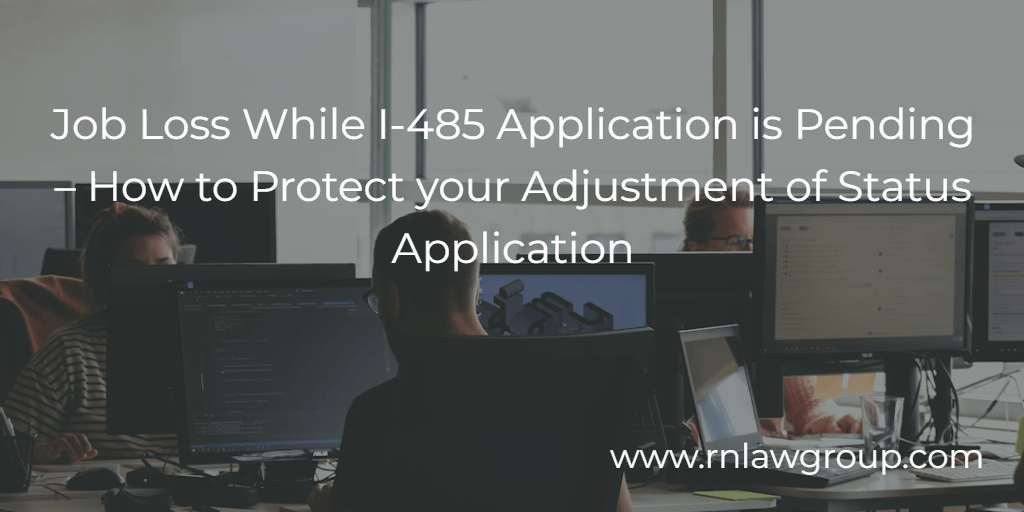
Job Loss While I-485 Application is Pending – How to Protect your Adjustment of Status Application
For employment-based green card applicants, the sudden loss of a job can have profound impacts on their application process, particularly if their priority date is far from being current on the Department of State’s visa bulletin. Applicants who have filed their I-485 applications should understand the consequences of a layoff or termination at this stage so they can consider their options and plan ahead if necessary.
AC21 Job Portability
Most employment-based I-485 applicants are aware of the availability of job portability under the American Competitiveness in the 21st Century Act (also known as AC21), which allows adjustment of status applicants to change jobs or employers once their I-485 application has been pending for at least 180 days. Indeed, if the I-485 application has been processing for the required 180-day period, and if the applicant meets the other requirements for job portability, AC21 can provide much-needed flexibility for employees facing years-long green card backlogs.
Continuity of a Job Offer – No Grace Period
However, not all applicants may be aware that in order for the I-485 application to be eventually approved, there must be continuous existence of a job offer from the time the I-485 application is filed, until it is approved. At the time the employment-based I-485 application is filed, the job offer supporting it is the one described in the I-140 petition, filed either concurrently with the I-485 or previously (if the I-140 petition was filed prior to the I-485, the employer must still confirm the job offer’s existence at the time the I-485 is filed by submitting Supplement J to the I-485 form). For the first 180 days that the I-485 application is pending, the job offer that forms the basis of the adjustment of status application must be the job from the I-140 petitioner. After the 180th day, that job offer can be from anyone or anywhere else, as long as it is full-time and in a same or similar occupation to the one described in the I-140 petition.
Technically, there should be no gap in the existence of a qualifying job offer from the time the I-485 application is filed until the green card is issued, even if that period of time is several years long due to priority date retrogression. This requirement of a continuous job offer may be surprising to applicants who have held nonimmigrant work visas for a number of years, such as H-1B or L-1, where a standard 60-day grace period automatically follows a worker’s last date of employment (subject to their I-94 expiration date). There is no grace period during which the I-485 application can be unsupported by a valid job offer, and an unexpected termination or layoff can therefore have profound consequences on the adjustment of status application.
Job Offer vs. Actual Employment
An important distinction though is that the I-485 requires continuity of a job offer, not necessarily continuous actual employment. Because the entire employment-based green card process is predicated upon a future permanent job, the I-485 application just requires existence of a valid job offer at all times, not necessarily current employment (whereas maintenance of nonimmigrant visa status does require current, actual employment). This means that if an adjustment of status applicant facing job loss can secure a qualifying job offer before the conclusion of their current employment, that job offer is sufficient to support the I-485 application, even if they do not immediately join the new company. If they will not be joining immediately, it is recommended that the offer be documented in writing, in the event USCIS issues a Request for Evidence or schedules the applicant for an in-person interview related to the I-485 application.
Self-Employment
Another area where I-485-eligible employment differs from work visa requirements is self-employment. While most nonimmigrant work visas do not allow for self-petitioning, self-employment can form the basis of a qualifying job offer for purposes of maintaining the pending I-485 application. The requirements under AC21 must still be met, i.e., the job must be full-time and in a same or similar occupation as the I-140-sponsored position. If it meets those requirements though, adjustment of status applicants with valid EADs may consider self-employment in the event of job loss (if the EAD has not yet been issued, this option is likely not available, due to the need to maintain the applicant’s nonimmigrant visa status).
Job Offer from Spouse
Similarly, if the I-485 applicant’s spouse has received their EAD through the adjustment of status process, or is otherwise employment-authorized (H-4 EAD, L2S, etc.), they may start their own business that could extend a job offer to the principal I-485 applicant. In this scenario, it is important that the company extending the job offer be a legitimate operating enterprise, doing business in an area that can offer a full-time position in the same or similar occupation as that described in the I-140 petition. If the principal applicant is actually employed by their spouse’s company, it is important that there still be an employer-employee relationship.
Documenting the Job Offer
As discussed above, it is recommended that any moves to a new job or job offer be documented in writing, in the form of an offer letter or employment contract, for example. It is not necessary to proactively file the I-485 J Supplement with USCIS, although any new employer should be willing to complete and sign the J supplement confirming the terms of the job offer, if needed. Typically, the J Supplement will only be needed if USCIS issues a Request for Evidence or schedules the applicant for an in-person interview related to the I-485 application.
Adjustment of status applicants should therefore have plans in place in the event of an unexpected job loss, particularly those who face long processing times due to priority date retrogression. Applicants in this situation may benefit from consulting with qualified immigration counsel to discuss their options.
By: Rebecca Chen
Rebecca Chen is a Partner at Reddy & Neumann. Her representation includes advising clients throughout the non-immigrant and immigrant visa application process, from initial filing, responding to various requests for evidence, and processing at overseas consulates. Her years of experience in the immigration field have made her a knowledgeable resource for complex business immigration matters.

